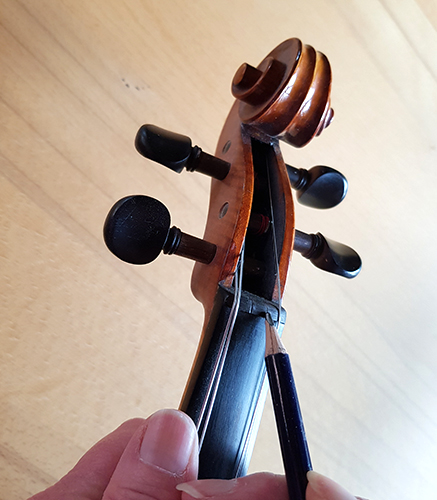Care and Maintenance
General Handling Tips
Always handle the violin by its neck and chinrest. This will prevent cracks on the top due to finger pressure, especially around the f-hole area. Try not to touch the varnish. Some varnishes are very soft and easily marked. Never place an instrument on a chair or lean it against anything. Always place the instrument in its case.
Repairs
Cracks and other damage should be repaired as soon as possible. A clean new crack is easier to repair than an old dirty one. Only allow a qualified, skilled luthier repair your instrument. It’s better to spend a little extra to get the work done correctly.
Temperature and Humidity
During periods of extreme temperatures or humidity, your instrument will get damaged if precautions are not taken. During low humidity conditions, the instrument may crack. Using a humidifier or ‘Dampit’ in your instrument case is recommended when the humidity is below 35 %. Do not leave the instrument in an automobile. The temperature inside an automobile can easily reach 160° F (50° C), this is hot enough to destroy most varnishes. If the instrument is frozen allow the temperature to stabilise for a few hours before removing it from its case. This will reduce the chance of seams opening and condensation forming.
Bow and Rosin
Loosen the bow after you finish playing, leaving the hair tight will warp or break the stick, especially if a drop in humidity occurs. Always wipe the rosin and perspiration from the instrument and bow before putting them away after playing. Rosin builds up with dirt to form a grey-black encrustation. Perspiration is acidic and will degrade varnish and corrode strings.
Other Tips
Add some graphite to the nut groove with a soft pencil from time to time. This will help to make the tuning easier and to extend the life of your strings.
If your peg begins to get stuck or if it slips, try using peg paste. Apply only a little at the spot where the peg touches the pegbox.
Control from time to time the position and angle of the bridge. The feet should be positioned in the centre of the f-notches, and the back side of the bridge (towards the tailpiece) should be upright - no tilting back or forwards. If your bridge is bent or warped or if the grooves are deeper than the diameter of each string, your bridge needs to be replaced.

Adding graphite to the nut

Adjusting the bridge

